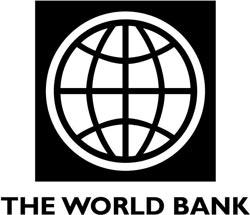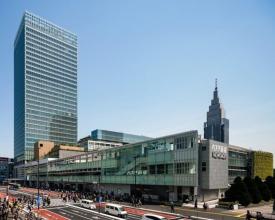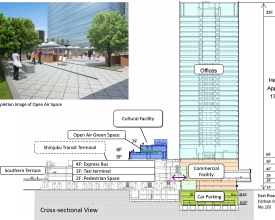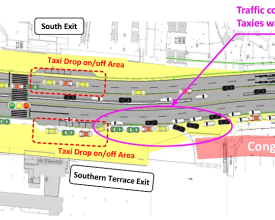
Desarrollo de un complejo integrado de transporte multimodal mediante colaboraciones público-privadas

Shinjuku es el mayor centro de negocios, cultura y ocio de Japón. Una amplia gama de actividades comerciales y servicios sociales se sustentan esencialmente en la estación de Shinjuku, el nudo de comunicaciones más transitado del país, con unos 3,5 millones de pasajeros diarios. Además de los servicios de trenes urbanos y regionales, numerosas líneas de autobuses interurbanos de Shinjuku conectan más de 300 ciudades y pueblos de 39 prefecturas de todo el país. Recientemente, el gobierno nacional inició el desarrollo de un complejo integrado de transporte multimodal combinado con la mejora de un sistema de circulación peatonal en colaboración con el sector privado. El proyecto completo consiste en tres grandes mejoras capitales de la salida sur de la zona de la estación de Shinjuku: la construcción de la terminal de autobuses de la autopista de Shinjuku (Busta Shinjuku), la ampliación de las aceras y la construcción de un paso subterráneo.
Contexto
Défis à relever
Diecinueve paradas de autobús independientes estaban incómodamente dispersas alrededor de la estación de tren y no estaban bien alineadas para los transbordos desde y hacia otros modos de viaje. Además, no había ninguna plaza pública frente a la salida sur de la estación, por lo que un gran volumen de pasajeros tenía que realizar un paseo estresante e inseguro a través de aceras estrechas y cruces sobre un viejo puente de carretera. Indudablemente, existía una necesidad inminente de grandes mejoras de capital debido al aumento del volumen de tráfico, las instalaciones viarias obsoletas y el empeoramiento de los servicios peatonales en torno a la estación.
Ubicación
Procesar
Resumen del proceso
El tránsito en autobús es un modo vital para establecer un sistema de transporte múltiple económicamente eficiente y socialmente asequible tanto en los países desarrollados como en los países en vías de desarrollo. Sin embargo, puede haber varias imágenes negativas con el tránsito de autobuses, como la inconveniente transferencia intermodal, el incómodo espacio de espera, la congestión en las calles y el funcionamiento poco fiable, que a menudo impiden a los viajeros disfrutar de los servicios de autobús. Los bloques de construcción presentan la aplicación del desarrollo de terminales modernas dirigidas por el público para mejorar la calidad de los servicios de autobús y reproducir entornos construidos seguros y agradables en distritos comerciales muy concurridos.
Bloques de construcción
Iniciativa pública para el desarrollo de nudos de transporte público
Busta Shinjuku fue desarrollado por el gobierno nacional como parte de un nuevo puente de carretera en una superficie de terreno artificial de unas 1,47 ha. La nueva instalación aúna múltiples funciones de tránsito (por ejemplo, una puerta de acceso a la estación de ferrocarril, una terminal de autobuses de autopista y una reserva de taxis) y gestiona sin problemas una amplia gama de líneas de autobuses interurbanos. Cabe destacar que esta terminal se desarrolló conjuntamente con la East Japan Railway Company, una de las mayores compañías ferroviarias privatizadas del país. La empresa también construyó un edificio de 170 metros de altura junto a la terminal. Esta torre alberga numerosas oficinas e inquilinos comerciales, espacios verdes al aire libre, instalaciones culturales, un vivero, una clínica médica y una granja-jardín. Además, el gobierno colaboró con varios proveedores privados de servicios para poner a disposición de los viajeros diversos servicios prácticos en la terminal y sus alrededores.
Se construyó recientemente un pasaje subterráneo para conectar ampliamente la zona de la estación de Shinjuku, cerca de Busta Shinjuku, con otra estación de metro operada por Tokyo Metro. Gracias a esta vía de 150 metros, los pasajeros pueden acceder y salir a pie del complejo de tránsito multimodal sin atascos ni tráfico de automóviles.
Factores facilitadores
- Liderazgo del sector público para coordinar a múltiples operadores de transporte mediante proyectos de mejora de capital
- Mecanismos de coordinación (por ejemplo, reuniones periódicas de las partes interesadas) para debatir el esquema del proyecto
- Resaltar los beneficios de la coordinación (idealmente en términos monetarios) para los proveedores privados de servicios de autobús por parte del sector público
- Capacidad de las empresas privadas para llevar a cabo grandes remodelaciones urbanas.
Lección aprendida
Cuando las paradas de autobús y las líneas proporcionadas por varios operadores privados están fragmentadas, el sector público necesita iniciar la coordinación eficiente de múltiples servicios de autobús a través de proyectos de mejora de capital y/o programas de gestión de la demanda. En particular, la inversión pública en el desarrollo de terminales modernas integradas puede desempeñar un papel fundamental no sólo para alinear las operaciones de transporte público, sino también para aliviar la congestión del tráfico y las externalidades negativas relacionadas alrededor de los distritos comerciales más concurridos.
Creación de entornos peatonales en todo el distrito
El desarrollo de una moderna terminal integrada suele incluir servicios interiores superiores para los pasajeros del transporte público. En el caso de Busta Shinjuku, el proyecto incluye la creación de un entorno peatonal en todo el distrito que abarque el complejo de tránsito. Se ampliaron las aceras a lo largo de la carretera nacional y se construyó un paso subterráneo conectado con la terminal y las estaciones de tren, así como con edificios de oficinas y comerciales, mediante la colaboración con las empresas ferroviarias privatizadas.
Factores facilitadores
- Coordinación con los planes a nivel de distrito
- Colaboración con promotores privados y empresas ferroviarias para la mejora del capital público
- Consultas con proveedores de servicios de autobús y residentes locales
Lección aprendida
La creación de un sistema de circulación peatonal en todo el distrito favorece una utilización más eficaz de los servicios de transporte en autobús y un mayor impacto comercial de la inversión pública en torno a una terminal de autobuses.
Servicios de calidad y hospitalidad
Una terminal de transporte multimodal debe contar con instalaciones y servicios que respondan a las distintas necesidades de los viajeros. El espacio interior de Busta Shinjuku cuenta con 146 asientos, aseos multiusos, guarderías, taquillas para monedas, cajeros automáticos y mostradores de servicio de billetes para la espera y el transbordo de pasajeros. Las pantallas eléctricas también proporcionan información en tiempo real sobre los horarios de los autobuses, los destinos de los servicios y el estado de las operaciones. Además de estos equipos y servicios básicos, también pone a disposición de los viajeros diversos servicios prácticos, como entrega de equipajes/paquetes, guardarropa, cambio de divisas, venta de billetes de viaje y acceso gratuito a Internet. Además, el centro de información turística de la terminal ofrece información multilingüe sobre Tokio y otras ciudades del país en inglés, chino y coreano.
Factores facilitadores
- Aplicación del Sistema de Transporte de Información (STI) para garantizar información actualizada en la terminal de tránsito multimodal.
- Prestar la debida atención a los pasajeros no nacionales y a las personas con discapacidad.
Lección aprendida
Proporcionar información en tiempo real en una terminal de tránsito multimodal permite a los pasajeros organizar su itinerario de viaje, minimizar el tiempo de espera y organizar actividades laborales o comerciales adicionales de forma más eficiente y agradable en torno al punto de transbordo. Además, la introducción de un sistema de señalización universal es esencial para gestionar los flujos dinámicos y complejos de pasajeros en tránsito y peatones en general en torno a las instalaciones de transporte público y propiedades comerciales privadas. La provisión de mostradores de información multilingües es de particular importancia para la hostelería, ya que los autobuses expresos interurbanos son una opción modal asequible para los visitantes extranjeros que no están familiarizados con el país para identificar y llegar a destinos turísticos atractivos en todo el país.
Impactos
Impacto económico: La mejora de los servicios de tránsito y la reducción de los costes de viaje atraen a más visitantes internacionales y nacionales a los distritos de oficinas y comercios de Shinjuku. Es probable que las reuniones cara a cara, más frecuentes y fluidas, aumenten las oportunidades de negocio y la productividad de Shinjuku. También es probable que los flujos de turistas, pasajeros y peatones mejorados y aumentados por el proyecto impulsen el consumo de servicios y las ventas de mercancías en el nuevo centro comercial y en las calles comerciales existentes alrededor de Busta Shinjuku y la estación de Shinjuku.
Impacto social: Las instalaciones y los caminos dentro y alrededor del edificio de la nueva terminal están diseñados sin barreras para todos los miembros de la sociedad, incluidas las personas que utilizan sillas de ruedas, empujan cochecitos de bebé y llevan maletas grandes. El fluido sistema de circulación facilita el acceso no sólo a las instalaciones de tránsito, sino también a diversos servicios sociales y actividades comerciales en los alrededores de Busta Shinjuku.
Impacto ambiental: La terminal de tránsito integrada mitiga las influencias negativas del tráfico callejero (por ejemplo, el ruido y la contaminación atmosférica) causadas por autobuses y taxis en los alrededores de la estación de Shinjuku, lo que podría contribuir a reducir las emisiones de gases de efecto invernadero a largo plazo. Busta Shinjuku también contiene varios elementos ecológicos, como muros verdes en los edificios, una plaza verde y una granja-jardín abierta al público en la azotea.
Beneficiarios
- Pasajeros del transporte público, turistas y peatones en los alrededores de la estación de Shinjuku
- Residentes y comerciantes del barrio de Shinjuku
- Operadores de autobuses, ferrocarriles y taxis
Objetivos de Desarrollo Sostenible
Historia
A continuación se detallan las tres mejoras principales.
Terminal de autobuses integrada en la autopista
Busta Shinjuku se construyó como parte de un nuevo puente de carretera en una superficie de terreno artificial de unas 1,47 ha y se inauguró en abril de 2016. La nueva instalación combina múltiples funciones de tránsito (por ejemplo, una puerta de entrada a la estación de tren, una terminal de autobuses de autopista y una reserva de taxis) y gestiona sin problemas una amplia gama de líneas de autobuses interurbanos. Su espacio interior también contiene asientos para 146 pasajeros, aseos multiusos, salas de guardería, taquillas para monedas, cajeros automáticos y mostradores de servicio de billetes para pasajeros en espera y en transbordo. Las pantallas eléctricas también proporcionan información en tiempo real sobre los horarios de los autobuses, los destinos de los servicios y el estado de las operaciones. Además de estos equipos y servicios básicos, la nueva terminal de tránsito, en colaboración con varias empresas privadas, pone a disposición de los viajeros diversos servicios prácticos, como entrega de equipajes/paquetes, guardarropa, cambio de divisas, venta de billetes de viaje y acceso gratuito a Internet. Además, el centro de información turística de la terminal ofrece información multilingüe sobre Tokio y otras ciudades del país en inglés, chino y coreano. Busta Shinjuku se ha desarrollado conjuntamente con la East Japan Railway Company, una de las mayores compañías ferroviarias privatizadas de Japón. La empresa inauguró en marzo de 2016 un edificio de 170 metros de altura, la torre JR Shinjuku Miraina, junto a Busta Shinjuku. Esta torre alberga numerosas oficinas e inquilinos comerciales, espacios verdes al aire libre, instalaciones culturales, un vivero, una clínica médica y una granja-jardín.
Amplias aceras
Un segmento del puente de carretera que da a las salidas de la estación de ferrocarril, considerado anteriormente como un cuello de botella de todo el flujo de tráfico de la Ruta Nacional 20, se amplió de una anchura de 30 metros a 50 metros, incluyendo la ampliación de las aceras de 5 metros a 15 metros. Aunque los taxis pueden esperar o recoger y dejar clientes en Busta Shinjuku, está totalmente prohibido aparcar en la calle y hacer cola en las aceras.
Amplio pasaje subterráneo
Se ha construido recientemente un pasaje subterráneo para conectar ampliamente la zona de la estación de Shinjuku cercana a Busta Shinjuku con otra estación de metro operada por Tokyo Metro. Con este pasaje de 150 metros, los pasajeros pueden acceder y salir del complejo de tránsito multimodal a pie sin atascos ni tráfico de coches.


